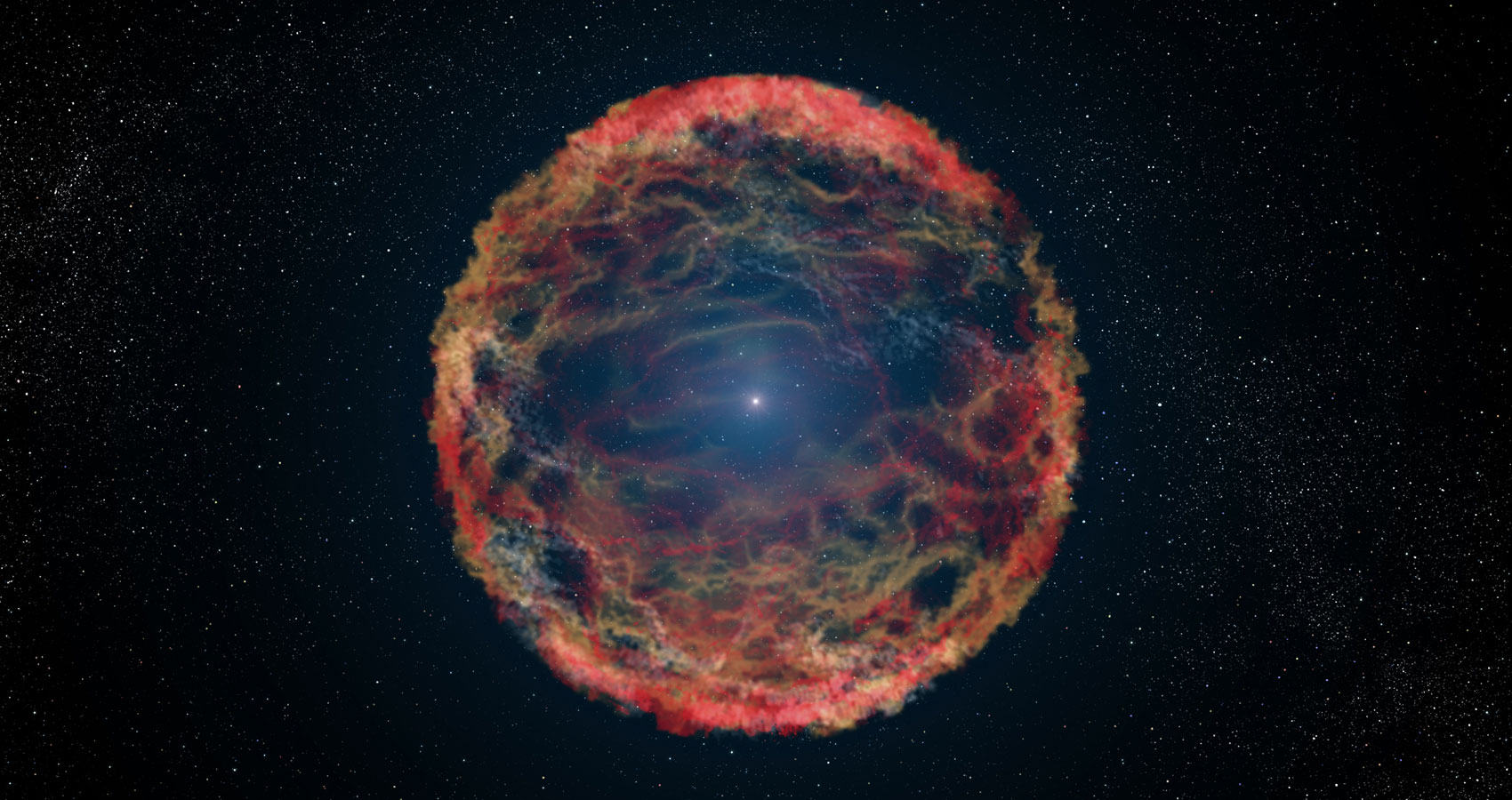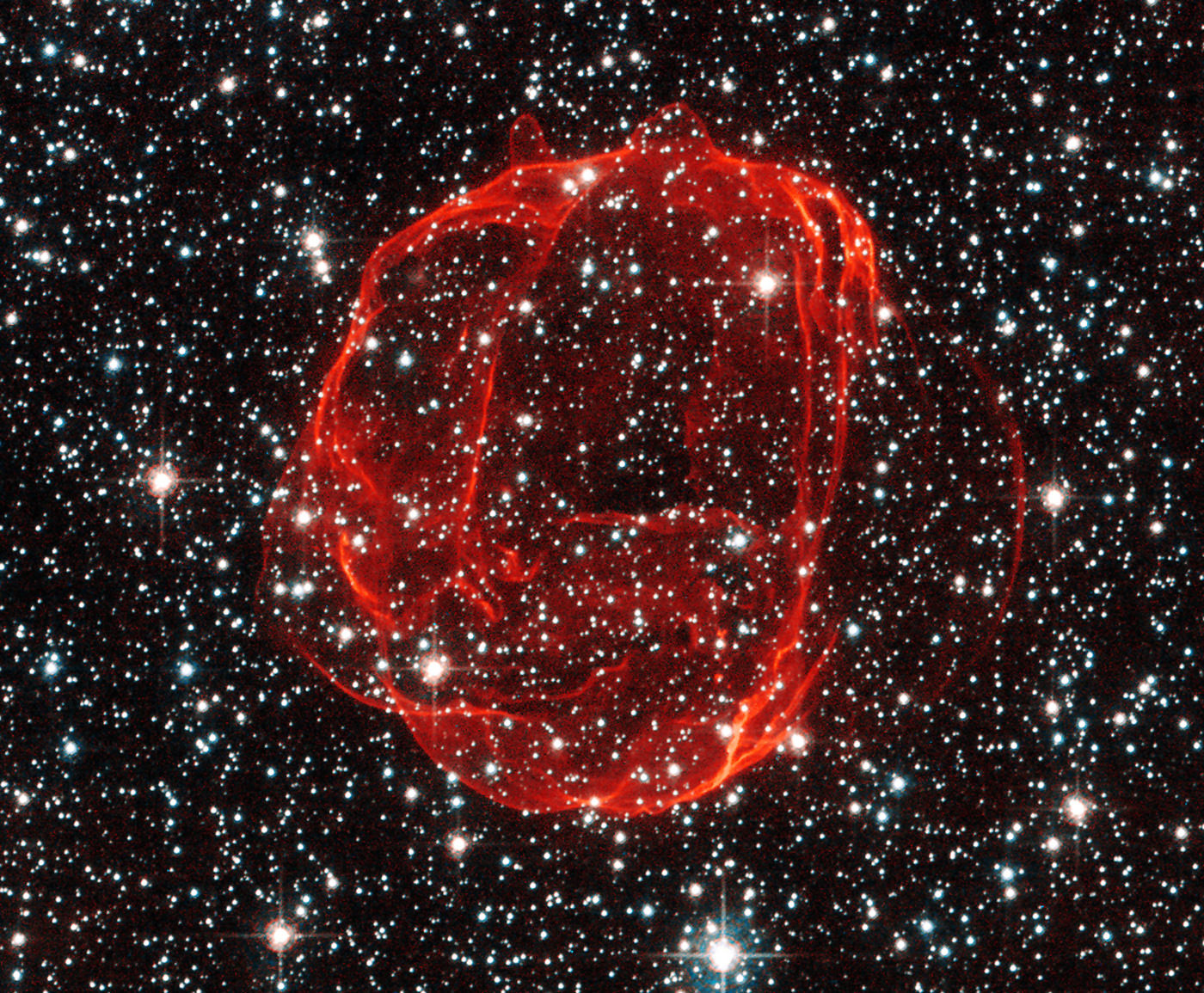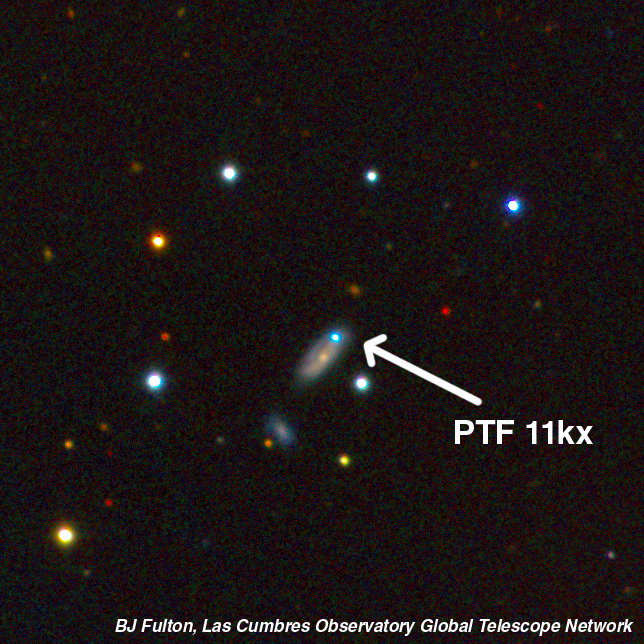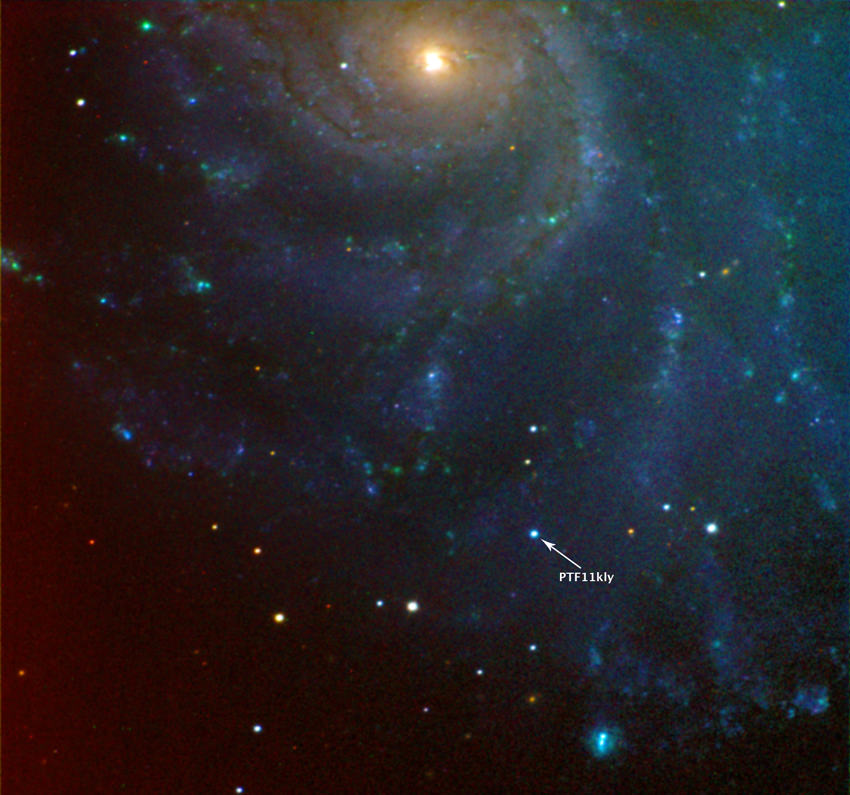Type Ia supernovae are an important tool for modern astronomy. They are thought to occur when a white dwarf star captures mass beyond the Chandrasekhar limit, triggering a cataclysmic explosion. Because that limit is the same for all white dwarfs, Type Ia supernovae all have about the same maximum brightness. Thus, they can be used as standard candles to determine galactic distances. Observations of Type Ia supernova led to the discovery of dark energy and that cosmic expansion is accelerating.
Continue reading “White Dwarf Measured Before it Exploded as a Supernova”Two Stars On A Death Spiral Set To Detonate As A Supernova
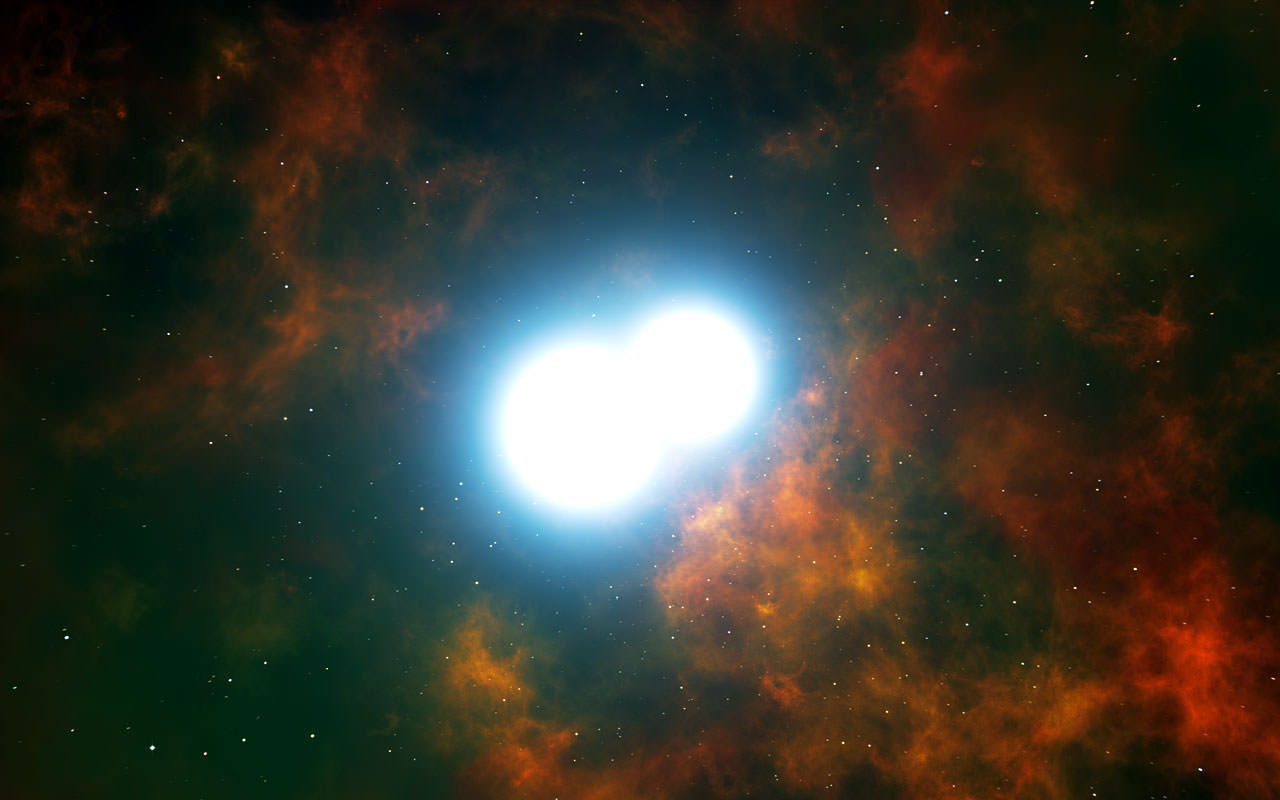
Two white dwarfs circle around one other, locked in a fatal tango. With an intimate orbit and a hefty combined mass, the pair is ultimately destined to collide, merge, and erupt in a titanic explosion: a Type Ia supernova.
Or so goes the theory behind the infamous “standard candles” of cosmology.
Now, in a paper published in today’s issue of Nature, a team of astronomers have announced observational support for such an arrangement – two massive white dwarf stars that appear to be on track for a very explosive demise.
The astronomers were originally studying variations in planetary nebulae, the glowing clouds of gas that red giant stars throw off as they fizzle into white dwarfs. One of their targets was the planetary nebula Henize 2-428, an oddly lopsided specimen that, the team believed, owed its shape to the existence of two central stars, rather than one. After observing the nebula with the ESO’s Very Large Telescope, the astronomers concluded that they were correct – Henize 2-428 did, in fact, have a binary star system at its heart.
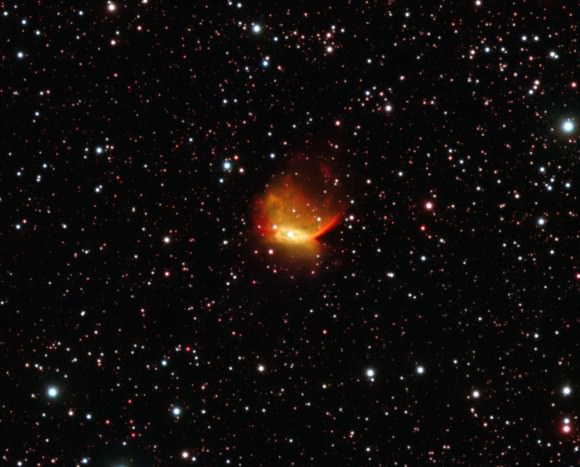
“Further observations made with telescopes in the Canary Islands allowed us to determine the orbit of the two stars and deduce both the masses of the two stars and their separation,” said Romano Corradi, a member of the team.
And that is where things get juicy.
In fact, the two stars are whipping around each other once every 4.2 hours, implying a narrow separation that is shrinking with each orbit. Moreover, the system has a combined heft of 1.76 solar masses – larger, by any count, than the restrictive Chandrasekhar limit, the maximum ~1.4 solar masses that a white dwarf can withstand before it detonates. Based on the team’s calculations, Henize 2-428 is likely to be the site of a type Ia supernova within the next 700 million years.
“Until now, the formation of supernovae Type Ia by the merging of two white dwarfs was purely theoretical,” explained David Jones, another of the paper’s coauthors. “The pair of stars in Henize 2-428 is the real thing!”
Check out this simulation, courtesy of the ESO, for a closer look at the fate of the dynamic duo:
Astronomers should be able to use the stars of Henize 2-428 to test and refine their models of type Ia supernovae – essential tools that, as lead author Miguel Santander-García emphasized, “are widely used to measure astronomical distances and were key to the discovery that the expansion of the Universe is accelerating due to dark energy.” This system may also enhance scientists’ understanding of the precursors of other irregular planetary nebulae and supernova remnants.
The team’s work was published in the February 9 issue of Nature. A copy of the paper is available here.
End the Year with a Bang! See a Bright Supernova in Virgo
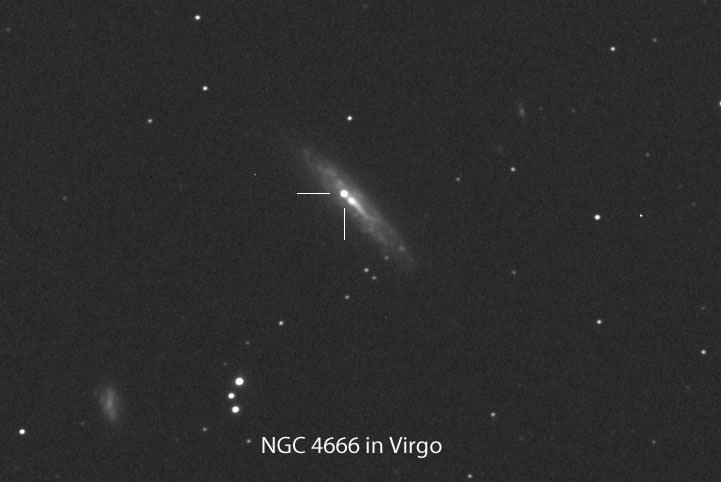
A 14th magnitude supernova discovered in the spiral galaxy NGC 4666 earlier this month has recently brightened to 11th magnitude, making it not only the second brightest supernova of the year, but an easy find in an 8-inch or larger telescope. I made a special trip into the cold this morning for a look and saw it with ease in my 10-inch (25-cm) scope at low power at magnitude 11.9.
Before the Moon taints the dawn sky, you may want to bundle up and have a look, too. The charts below will help you get there.
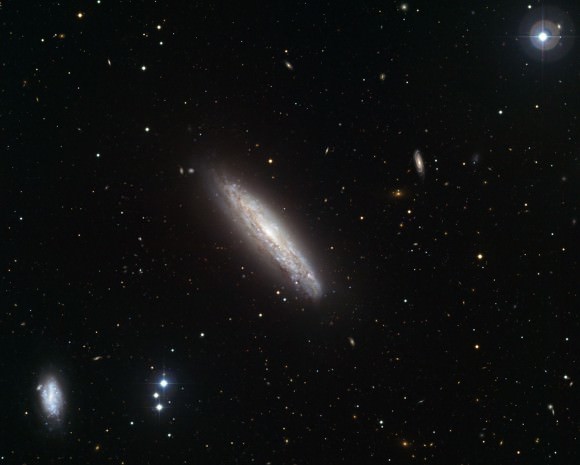
With the temporary name ASASSN-14lp, this Type Ia supernova was snatched up by the catchy-titled “Assassin Project”, short for Automated Sky Survey for SuperNovae (ASAS-SN) on December 9th. Only 80 million light years from Earth, NGC 4666 is a relatively nearby spiral galaxy famous enough to earn a nickname.
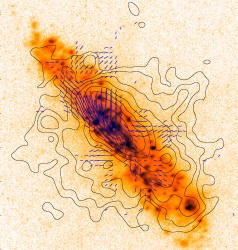
Called the Superwind Galaxy, it’s home to waves of intense star formation thought to be caused by gravitational interactions between it and its neighboring galaxies, including NGC 4668, visible in the lower left corner of the photo above.
Supernovae also play a part in powering the wind which emerges from the galaxy’s central regions like pseudopods on an amoeba. X-ray and radio light show the outflows best. How fitting that a bright supernova should happen to appear at this time. Seeing one of the key players behind the superwind with our own eyes gives us a visceral feel for the nature of its home galaxy.
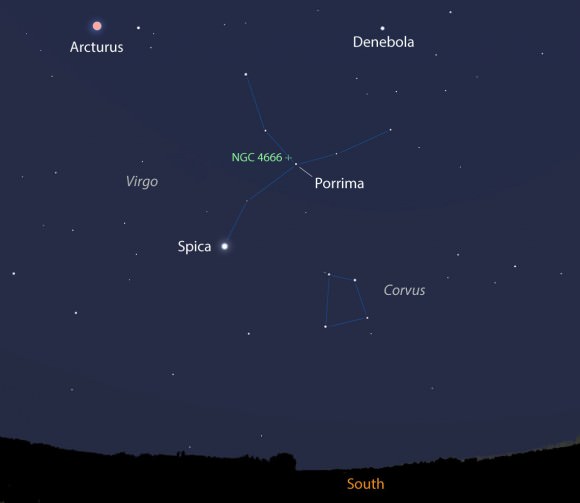
Spectra taken of ASASSN-14lp show it to be a Type Ia object involving the explosive burning of a white dwarf star in a binary system. The Earth-size dwarf packs the gravitational might of a sun-size star and pulls hydrogen gas from the nearby companion down to its surface. Slowly, the dwarf gets heavier and more massive.
When it attains a mass 1.4 times that of the sun, it can no longer support itself. The star suddenly collapses, heats to incredible temperatures and burns up explosively in a runaway fusion reaction. Bang! A supernova.
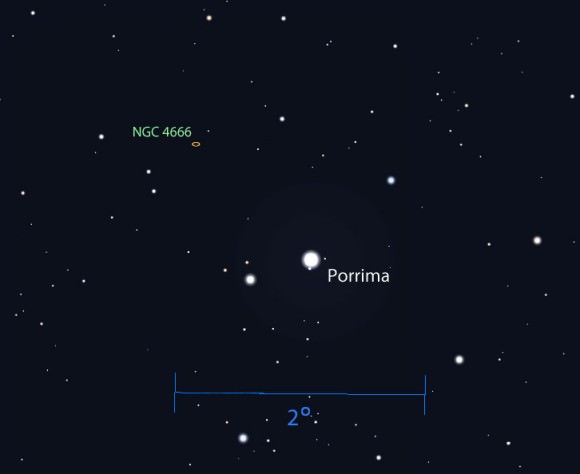
Here are a couple maps to help you find the new object. Fortunately, it’s high in the sky just before the start of dawn in the “Y” of Virgo only a degree or so from the 3rd magnitude double star Porrima, also known as Gamma Virginis. Have at it and let us know if you spot the latest superwind-maker.
For more photos and magnitude updates, check out Dave Bishop’s page on the supernova. You can also print a chart with comparison magnitudes by clicking over to the AAVSO and typing in ASASSN-14lp in the “name” box.
Possible Bright Supernova Lights Up Spiral Galaxy M61

I sat straight up in my seat when I learned of the discovery of a possible new supernova in the bright Virgo galaxy M61. Since bright usually means close, this newly exploding star may soon become visible in smaller telescopes. It was discovered at magnitude +13.6 on October 29th by Koichi Itagaki of Japan, a prolific hunter of supernovae with 94 discoveries or co-discoveries to his credit. Itagaki used a CCD camera and 19.6-inch (0.50-m) reflector to spy the new star within one of the galaxy’s prominent spiral arms. Comparison with earlier photos showed no star at the position. Itagaki also nabbed not one but two earlier supernovae in M61 in December 2008 and November 2006.
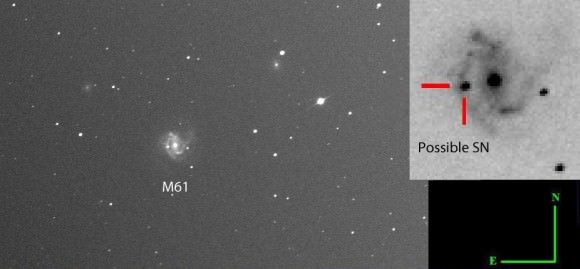
Overnight, Ernesto Guido and crew used a remote telescope in New Mexico to confirm the new object. We’re still waiting for a spectrum to be absolutely sure this is the real deal and also to determine what type of explosion occurred. In the meantime, it may well brighten in the coming mornings.
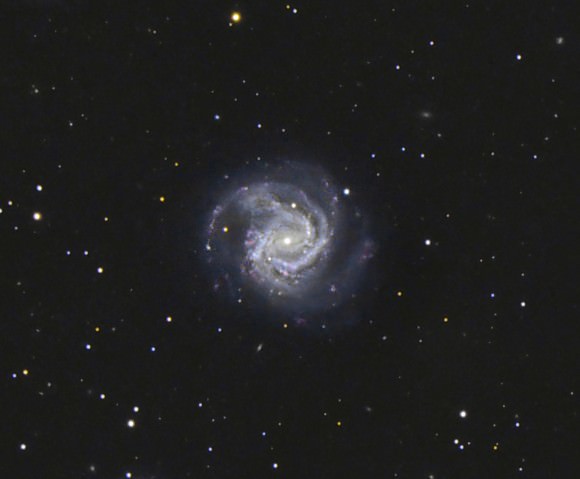
Supernovae are divided into two broad categories – Type Ia and Type II. In a Type Ia event, a planet-sized white dwarf star in close orbit around a normal star siphons off matter from its companion which builds up on the surface of the dwarf until it reaches critical mass at which point the core ignites and consumes itself and the star in one titanic nuclear fusion reaction. A cataclysmic explosion ensues as the star self-destructs in blaze of glory.
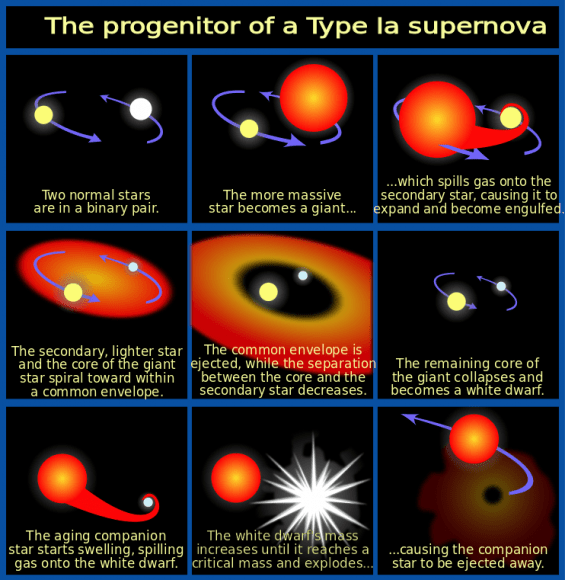
Type Ia explosions can become 5 billion times brighter than the Sun – the reason we can see them across so many light years – and eject matter into space at 5,000 – 20,000 km/second. Type II events mark the end of the life of a massive supergiant star. As these behemoths age, they burn by fusing heavier and heavier elements in their cores from hydrogen to carbon to silicon and finally, iron-nickel. Iron is inert and can’t be cooked or fused to create more energy. The star’s internal heat source, which has been staving back the force of gravity all these millions of years, shuts down. Gravity takes hold with a vengeance, the star quickly collapses then rebounds in a titanic explosion. Ka-boom!
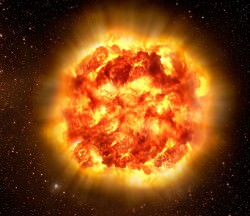
Like the Type Ia event, a Type II supernova grows to fantastic brilliance. Besides a legacy of radiant light, star debris, the creation of heavy elements like gold and lead, a Type II event will sometimes leave behind a tiny, city-sized, rapidly-spinning neutron star – the much compressed core of the original star – or even a black hole. So yes, life can continue for a giant star after a supernova event. But like seeing a former classmate at your 40th high school reunion, you’d hardly recognize it.
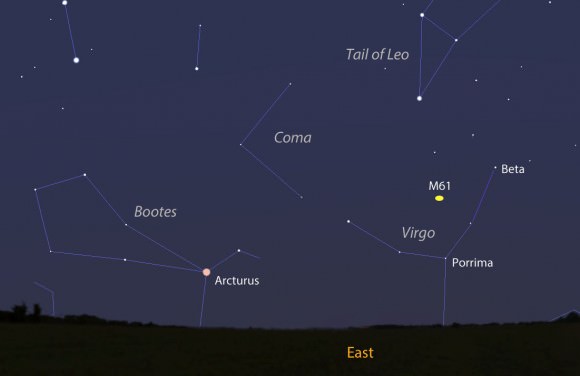
Are you itching to see this new supernova for yourself? Here are a couple maps to help you find it. M61 is located in the middle of the “Y” of Virgo not far from the familiar bright double star Gamma Virginis. From many locations, the galaxy climbs to 15-20° altitude in the east-southeast sky just before the start of dawn, just high enough for a good view. Once you find the galaxy, look for a small “star” superimposed on its eastern spiral arm as shown in the photo at the top of this article.
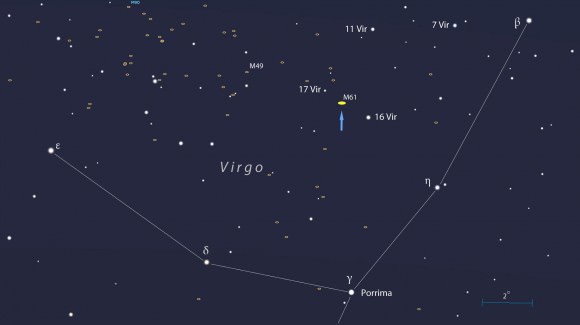
I’ll be out there with my scope watching and will report back once it’s established what type of supernova happens to be blowing up in our eyepieces. More information about the new object can be found anytime at David Bishop’s Latest Supernovae site. Good luck, clear skies!
** Update Nov. 1 : M61’s supernova now has a name and type! SN 2014dt is a Type Ia (exploding white dwarf) with some peculiarities in its spectrum. It’s also little brighter at magnitude +13.2.
SOFIA Gives Scientists a First-Class View of a Supernova
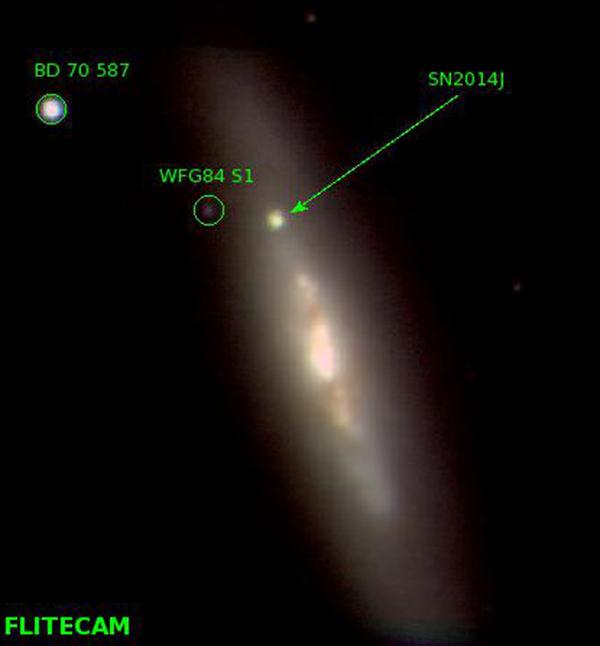
Astronomers wanting a closer look at the recent Type Ia supernova that erupted in M82 back in January are in luck. Thanks to NASA’s Stratospheric Observatory for Infrared Astronomy (SOFIA) near-infrared observations have been made from 43,000 feet — 29,000 feet higher than some of the world’s loftiest ground-based telescopes.
(And, technically, that is closer to M82. If only just a little.)
All sarcasm aside, there really is a benefit from that extra 29,000 feet. Earth’s atmosphere absorbs a lot of wavelengths of the electromagnetic spectrum, especially in the infrared and sub-millimeter ranges. So in order to best see what’s going on in the Universe in these very active wavelengths, observational instruments have to be placed in very high, dry (and thus also very remote) locations, sent entirely out into space, or, in the case of SOFIA, mounted inside a modified 747 where they can simply be flown above 99% of the atmosphere’s absorptive water vapor.

During a recent 10-hour flight over the Pacific, researchers aboard SOFIA turned their attention to SN2014J, one of the closest Type Ia “standard candle” supernovas that have ever been seen. It appeared suddenly in the relatively nearby Cigar Galaxy (M82) in mid-January and has since been an exciting target of observation for scientists and amateur skywatchers alike.
In addition to getting a bird’s-eye-view of a supernova, they used the opportunity to calibrate and test the FLITECAM (First Light Infrared Test Experiment CAMera) instrument, a near infrared camera with spectrographic capabilities mounted onto SOFIA’s 2.5-meter German-built main telescope.
What they’ve found are the light signatures of heavy metals being ejected by the exploding star. (Rock on, SN2014J.)
“When a Type Ia supernova explodes, the densest, hottest region within the core produces nickel 56,” said Howie Marion from the University of Texas at Austin, a co-investigator aboard the flight. “The radioactive decay of nickel-56 through cobalt-56 to iron-56 produces the light we are observing tonight. At this life phase of the supernova, about one month after we first saw the explosion, the H- and K-band spectra are dominated by lines of ionized cobalt. We plan to study the spectral features produced by these lines over a period of time and see how they change relative to each other. That will help us define the mass of the radioactive core of the supernova.”
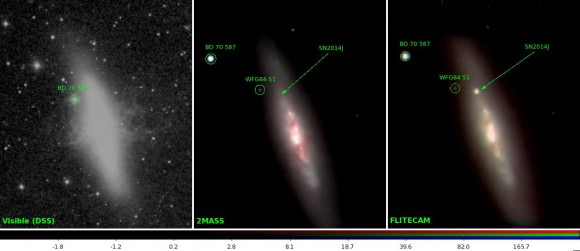
Further observations from SOFIA will help researchers learn more about the evolution of Type Ia supernovas, which in addition to being part of the life cycles of certain binary-pair stars are also valuable tools used by astronomers to determine distances to far-off galaxies.
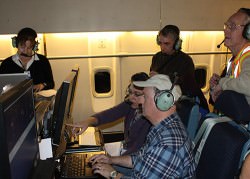
“To be able to observe the supernova without having to make assumptions about the absorption of the Earth’s atmosphere is great,” said Ian McLean, professor at UCLA and developer of FLITECAM. “You could make these observations from space as well, if there was a suitable infrared spectrograph to make those measurements, but right now there isn’t one. So this observation is something SOFIA can do that is absolutely unique and extremely valuable to the astronomical community.”
Read more in a SOFIA news article by Nicholas Veronico here.
Source: SOFIA Science Center, NASA Ames
UPDATE 4 March 2014: The FY 2015 budget request proposed by the White House will effectively shelf the SOFIA mission, redirecting its funding toward planetary missions like Cassini and an upcoming Europa mission. Unfortunately, SOFIA’s flying days are now numbered, unless German partner DLR increases its contribution. Read more here.
The Rosy Remains of a Star’s Final Days
Stars like our Sun can last for a very long time (in human terms, anyway!) somewhere in the neighborhood of 10-12 billion years. Already over 4.6 billion years old, the Sun is entering middle age and will keep on happily fusing hydrogen into helium for quite some time. But eventually even stars come to the end of their lives, and their deaths are some of the most powerful — and beautiful — events in the Universe.
The wispy, glowing red structures above are the remains of a white dwarf in the neighboring Large Magellanic Cloud 150,000 light-years away. Supernova remnant SNR 0519 was created about 600 years ago (by our time) when a star like the Sun, in the final stages of its life, gathered enough material from a companion to reach a critical mass and then explode, casting its outer layers far out into space to create the cosmic rose we see today.
As the hydrogen material from the star plows outwards through interstellar space it becomes ionized, glowing bright red.
SNR 0519 is the result of a Type Ia supernova, which are the result of one white dwarf within a binary pair drawing material onto itself from the other until it undergoes a core-collapse and blows apart violently. The binary pair can be two white dwarfs or a white dwarf and another type of star, such as a red giant, but at least one white dwarf is thought to always be the progenitor.
Read more: A New Species of Type Ia Supernova?
A recent search into the heart of the remnant found no surviving post-main sequence stars, suggesting that SNR 0519 was created by two white dwarfs rather than a mismatched pair. Both stars were likely destroyed in the explosion, as any non-degenerate partner would have remained.
This image was chosen as ESA/Hubble’s Picture of the Week. See the full-sized version here.
Credit: ESA/Hubble & NASA. Acknowledgement: Claude Cornen
New Kind of “Runt” Supernovae Could be Lurking Unseen

Imagine this “Death from the Skies” scenario; a tiny supernova lurks unseen near our Sun. Astronomers from the Harvard-Smithsonian Center for Astrophysics (CfA) announced the discovery of just such an object today and while it is not nearby, this new kind of supernova is so faint it has been hiding in the shadows.
Until now, supernovae have come in two main versions. In one scenario, a huge star, 10 to 100 times more massive as our Sun, collapses causing a colossal stellar explosion. Another scenario, known as Type Ia supernovae, occurs when material from a parent star streams onto the surface of a white dwarf. Over time, so much material falls onto the white dwarf that it raises the core temperature igniting carbon and causing a runaway fusion reaction. This event completely disrupts the white dwarf and results in a colossal stellar explosion.
Now astronomers have found a third type that is fainter and less energetic than a Type Ia. Called a Type Iax supernova, it is “essentially a mini supernova,” says lead author of the study Ryan Foley, Clay Fellow at the Harvard-Smithsonian Center for Astrophysics (CfA). “It’s the runt of the supernova litter.”
Being only about one-hundredth as bright as their supernova siblings, Foley calculates that Type Iax supernovae are about as third as common as Type Ia supernovae. The researchers also did not find them in elliptical galaxies, filled with older stars, suggesting that Type Iax supernovae come from young star systems.
So far, Foley and his team identified 25 examples of this new type of supernova. Based on observations, the team found that the new Type Iax supernovae come from binary star systems containing a white dwarf and a companion star that has burned all of its hydrogen, leaving an outer layer that is helium rich.
In a press release, Foley says they are not sure what triggers the Type Iax supernova. One explanation involves the ignition of the outer helium layer from the companion star. The resulting shockwave slams into the white dwarf and disrupts it, causing the explosion. Alternately, the white dwarf might ignite first due to the overlying helium shell it has collected from the companion star.
“Either way, it appears that in many cases the white dwarf survives the explosion unlike in a Type Ia supernova where the white dwarf is completely destroyed,” says Foley. “The star will be battered and bruised but it might live to see another day.”
Supernovae explosions release so much energy as heat and light that they outshine entire galaxies for brief periods of time. The extremely hot conditions naturally create new heavier elements, such as gold, lead, nickel, zinc and copper. The explosion enriches the surrounding area leaving material for new stars to form.
“Type Iax supernovas aren’t rare, they’re just faint,” explains Foley. “For more than a thousand years, humans have been observing supernovas. This whole time, this new class has been hiding in the shadows.”
This research has been accepted for publication in The Astrophysical Journal and is available online.
A New Species of Type Ia Supernova?
Artist’s conception of a binary star system that produces recurrent novae, and ultimately, the supernova PTF 11kx. (Credit: Romano Corradi and the Instituto de Astrofísica de Canarias)
Although they have been used as the “standard candles” of cosmic distance measurement for decades, Type Ia supernovae can result from different kinds of star systems, according to recent observations conducted by the Palomar Transient Factory team at California’s Berkeley Lab.
Judging distances across intergalactic space from here on Earth isn’t easy. Within the Milky Way — and even nearby galaxies — the light emitted by regularly pulsating stars (called Cepheid variables) can be used to determine how far away a region in space is. Outside of our own local group of galaxies, however, individual stars can’t be resolved, and so in order to figure out how far away distant galaxies are astronomers have learned to use the light from much brighter objects: Type Ia supernovae, which can flare up with a brilliance equivalent to 5 billion Suns.
Type Ia supernovae are created from a special pairing of two stars orbiting each other: one super-dense white dwarf drawing material in from a companion until a critical mass — about 40% more massive than the Sun — is reached. The overpacked white dwarf suddenly undergoes a rapid series of thermonuclear reactions, exploding in an incredibly bright outburst of material and energy… a beacon visible across the Universe.
Because the energy and luminance of Type Ia supernovae have been found to be so consistently alike, distance can be gauged by their apparent brightness as seen from Earth. The dimmer one is when observed, the farther away its galaxy is. Based on this seemingly universal similarity it’s been thought that these supernovae must be created under very similar situations… especially since none have been directly observed — until now.
An international team of astronomers working on the Palomar Transient Factory collaborative survey have observed for the first time a Type Ia supernova-creating star pair — called a progenitor system — located in the constellation Lynx. Named PTF 11kx, the system, estimated to be some 600 million light-years away, contains a white dwarf and a red giant star, a coupling that has not been seen in previous (although indirect) observations.
“It’s a total surprise to find that thermonuclear supernovae, which all seem so similar, come from different kinds of stars,” says Andy Howell, a staff scientist at the Las Cumbres Observatory Global Telescope Network (LCOGT) and a co-author on the paper, published in the August 24 issue of Science. “How could these events look so similar, if they had different origins?”
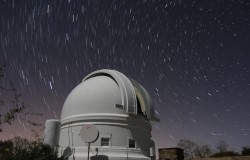 The initial observations of PTF 11kx were made possible by a robotic telescope mounted on the 48-inch Samuel Oschin Telescope at California’s Palomar Observatory as well as a high-speed data pipeline provided by the NSF, NASA and Department of Energy. The supernova was identified on January 16, 2011 and supported by subsequent spectrography data from Lick Observatory, followed up by immediate “emergency” observations with the Keck Telescope in Hawaii.
The initial observations of PTF 11kx were made possible by a robotic telescope mounted on the 48-inch Samuel Oschin Telescope at California’s Palomar Observatory as well as a high-speed data pipeline provided by the NSF, NASA and Department of Energy. The supernova was identified on January 16, 2011 and supported by subsequent spectrography data from Lick Observatory, followed up by immediate “emergency” observations with the Keck Telescope in Hawaii.
“We basically called up a fellow UC observer and interrupted their observations in order to get time critical spectra,” said Peter Nugent, a senior scientist at the Lawrence Berkeley National Laboratory and a co-author on the paper.
The Keck observations showed the PTF 11kx post-supernova system to contain slow-moving clouds of gas and dust that couldn’t have come from the recent supernova event. Instead, the clouds — which registered high in calcium in the Lick spectrographic data — must have come from a previous nova event in which the white dwarf briefly ignited and blew off an outer layer of its atmosphere. This expanding cloud was then seen to be slowing down, likely due to the stellar wind from a companion red giant.
(What’s the difference between a nova and a supernova? Read NASA’s STEREO Spots a New Nova)
Eventually the decelerating nova cloud was impacted by the rapidly-moving outburst from the supernova, evidenced by a sudden burst in the calcium signal which had gradually diminished in the two months since the January event. This calcium burst was, in effect, the supernova hitting the nova and causing it to “light up”.
The observations of PTF 11kx show that Type Ia supernova can occur in progenitor systems where the white dwarf has undergone nova eruptions, possibly repeatedly — a scenario that many astronomers had previously thought couldn’t happen. This could even mean that PTF 11kx is an entirely new species of Type Ia supernova, and while previously unseen and rare, not unique.
Which means our cosmic “standard candles” may need to get their wicks trimmed.
“We know that Type 1a supernovae vary slightly from galaxy to galaxy, and we’ve been calibrating for that, but this PTF 11kx observation is providing the first explanation of why this happens,” Nugent said. “This discovery gives us an opportunity to refine and improve the accuracy of our cosmic measurements.”
Source: Berkeley Lab news center
Inset images: PTF 11kx observation (BJ Fulton, Las Cumbres Observatory Global Telescope Network) / The 48-inch Samuel Oschin Telescope dome at Palomar Observatory. Video: Romano Corradi and the Instituto de Astrofísica de Canarias
Shiny New Supernova Spotted in Nearby Galaxy
[/caption]
Literally an event of stellar proportions, a new Type Ia supernova has been identified in a spiral galaxy 25 million light-years away! Spotted by Caltech’s Palomar Transit Factory project, this supernova, categorized as PTF11kly, is located 58″.6 west and 270″.7 south of the center of M101. It was first seen yesterday, August 24, 2011.
According to AAVSO Special Notice #250 P. Nugent et al. reported in Astronomical Telegram #3581 that a possible Type-Ia supernova has been discovered by the Palomar Transient Factory shortly after eruption in the galaxy M101 and has been designated “PTF11kly”. The object is currently at a magnitude of 17.2, but may well rise by several magnitudes. The object is well placed within M101 for good photometry, and observations of this potential bright SNIa are strongly encouraged.
There are currently no comparison stars available in VSP for this field; please indicate clearly the comparison stars that you use for photometry when reporting observations to AAVSO. Please retain your images and/or photometry for recalibration when comparison star magnitudes are available.
Need coordinates? The (J2000) coordinates reported for the object are RA: 14:03:05.81 , Dec: +54:16:25.4. Messier 101 is located in the constellation of Ursa Major at RA: 14h 03m 12.6s Dec: +54 20′ 57″
Charts for PTF11kly may be plotted with AAVSO VSP. You should select the DSS option when plotting, as the galaxy will not appear on standard charts. This object has been assigned the name “PTF11kly” for use with AAVSO VSP and WebObs; please use this name when reporting observations until it is conclusively classified as a supernova and a proper SN name is assigned.
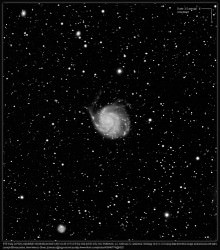
Type Ia supernovae are the result of a binary pair of mismatched stars, the smaller, denser one feeding on material drawn off its larger companion until it can no longer take in any more material. It then explodes in a catastrophic event that outshines the brightness of its entire galaxy! Astronomers believe that Type Ia supernovae occur in pretty much the same fashion every time and thus, being visible across vast distances, have become invaluable benchmarks for measuring distance in the Universe and gauging its rate of expansion.
The fact that this supernova was spotted literally within a day of its occurrence – visibly speaking, of course, since M101 is 25 million light-years away and thus 25 million years in our past – will be extremely handy for astronomers who will have the opportunity to study the event from beginning to end and learn more about some of the less-understood processes involved in Type Ia events.
“We caught this supernova earlier than we’ve ever discovered a supernova of this type. On Tuesday, it wasn’t there. Then, on Wednesday, boom! There it was – caught within hours of the explosion. As soon as I saw the discovery image I knew we were onto something big.”
– Andy Howell, staff scientist at Las Cumbres Observatory Global Telescope
It’s a big Universe and there are a lot of stars and therefore a lot of supernovae, but getting a chance to study one occurring so recently in a galaxy so relatively close to our own is something that is getting many astronomers very excited.
So, get those CCD camera out and best of luck!
Keep up with the latest news on PTF11kly on the rochesterastronomy.org site, and check out Phil Plait’s informative article on his BadAstronomy blog. Also read the press release from the University of California here.
Tammy Plotner also contributed to this article.
_________________________
Jason Major is a graphic designer, photo enthusiast and space blogger. Visit his website Lights in the Dark and follow him on Twitter @JPMajor and on Facebook for more astronomy news and images!

